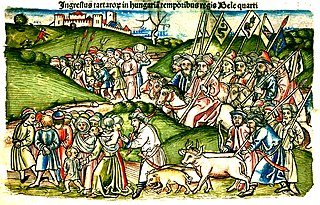
Back الغزو المغولي الأول للمجر Arabic Mongolský vpád do Uher Czech Goresgyniad Hwngari gan y Mongolwyr (1241–42) CY Mongola invado en Hungarujo EO Primera invasión mongola de Hungría Spanish Invasions mongoles de la Hongrie French Tatárjárás Magyarországon Hungarian Prima invasione mongola dell'Ungheria Italian მონღოლების პირველი შეჭრა უნგრეთში KA Najazd mongolski na Węgry Polish
| First Mongol invasion of Hungary | |||||||
|---|---|---|---|---|---|---|---|
| Part of the Mongol invasion of Europe | |||||||
 Mongol invasion depicted in Johannes de Thurocz's Chronica Hungarorum | |||||||
| |||||||
| Belligerents | |||||||
|
Minor belligerent: (until April 1241) |
(Mongol Empire) | ||||||
| Commanders and leaders | |||||||
|
Köten |
| ||||||
| Units involved | |||||||
|
Primarily light cavalry Knights Templar Crossbowmen Infantry |
Cavalry, predominantly horse archers and lancers Stone throwers Possibly Chinese firearm units and other gunpowder units | ||||||
| Strength | |||||||
|
~30,000 soldiers (contemporary sources)[1][2] Other estimations (Mohi only): 80,000[3] 25,000[4][5] 50,000[6] |
~40,000 cavalry (contemporary sources)[7] Other estimations (Mohi only): 70,000[8] 25,000[4][5] 50,000[6] | ||||||
| Casualties and losses | |||||||
|
10,000+ soldiers killed[9] | Unknown, but heavy[10][11][12][13][14] | ||||||
The first invasion of the Kingdom of Hungary by the Mongol Empire started in March 1241. The Mongols started to withdraw in late March 1242.
- ^ William of Rubruck. "The journey of William of Rubruck to the eastern parts of the world, 1253-55." Translated by William Woodville Rockhill. Page 281. "It would be very easy to conquer or to pass through all these countries. The King of Hungary has not at most XXX thousand soldiers."
- ^ Sverdrup, p.115: "A near-contemporary source says the Hungarians lost 10,000 men in the Mohi battle. This is no precise number, but as most of the army was lost it may be close to what the author believed the size of the whole army was. When Mongol officer Siban spied the Hungarian camp some weeks before the battle he counted 40 units [Rashid al-Din, 2:474]. In those days the Hungarian units, the so-called banderias, were usually between 50 and 400 men strong [See Julius Bartl, "Slovak History: Chronology and Lexicon" (Bratislava 2002), p. 191]. An average size of 250 would indeed give a total of 10,000 men." [a maximum average of 400 would have given 16,000 men].
- ^ Carey, Brian Todd, p. 124
- ^ a b Markó, László (2000), Great Honours of the Hungarian State, Budapest: Magyar Könyvklub, ISBN 963-547-085-1
- ^ a b Liptai, Ervin (1985), Military History of Hungary, Budapest: Zrínyi Katonai Kiadó, ISBN 963-326-337-9
- ^ a b Sverdrup, p. 115, citing Kosztolnyik.
- ^ Sverdrup, p. 114-115, citing Rashid al-Din's chronicles, 1:198, 2:152. Rashid Al-Din's figures give Batu and Subutai about 40,000 horsemen total when they invaded Central Europe in 1241 (including Turkic auxiliaries recruited since the conquest of Rus), divided into five columns; one made a diversionary attacks into Poland, but rejoined with the other four in Hungary after Legnica and participated in the invasion.
- ^ Carey states on p. 128 that Batu had 40,000 in the main body and ordered Subotai to take 30,000 troops in an encircling maneuver. Batu commanded the central prong of the Mongols' three-pronged assault on eastern Europe. This number seems correct when compared with the numbers reported at the Battles of Leignitz to the North and Hermannstadt (Sibiu) to the South. All three victories occurred in the same week.
- ^ Sverdrup, p. 115. Citing: Gustav Strakoschd-Grassmann. Der Einfall Der Mongolen In Mitteleuropa In Den Jahren 1241 und 1242 (Innsbruck, 1893), p.183.
- ^ The Mongols in the West, Denis Sinor, Journal of Asian History, Vol. 33, No. 1 (1999), page 15;"...on April 11, Batu's forces executed a night attack on the Hungarian camp, inflicting terrible losses on its trapped defenders..[..]..While the outcome of the encounter is beyond dispute-some call it a massacre rather than a battle-historians disagree on their assessments of Béla's apparent ineptitude. Of course the Hungarians could have done better; but it is beyond doubt that no "ad hoc", feudal type force could have matched the well disciplined, highly trained, professional soldiers of the Mongol army. A seldom considered measure of the efficacy of the Hungarian resistance is the size of the losses sustained by the attackers. These were very heavy.."
- ^ John France, Perilous Glory: The Rise of Western Military Power, (Yale University Press, 2011), 144.
- ^ A Global Chronology of Conflict: From the Ancient World to the Modern Middle East, Vol. I, ed. Spencer C. Tucker, (ABC-CLIO, 2010), 279;"Although Mongol losses in the battle are heavy...".
- ^ The Mongol Empire: A Historical Encyclopedia, Vol. II, ed. Timothy May, (ABC-CLIO, 2017), 103.
- ^ Obrusánszky, Borbála (September 2017). "A tatárok kivonulásának okai" [The reasons for the departure of the Tatars] (PDF). Székelyföld - kulturális folyóirat (in Hungarian). Vol. 21/9. Csíkszereda: Hargita Megye Tanácsa, Hargita Kiadóhivatal, Székelyföld Alapítvány. pp. 113–129. ISSN 1453-3871. Archived from the original on 2023-12-04. Retrieved 2023-05-24.